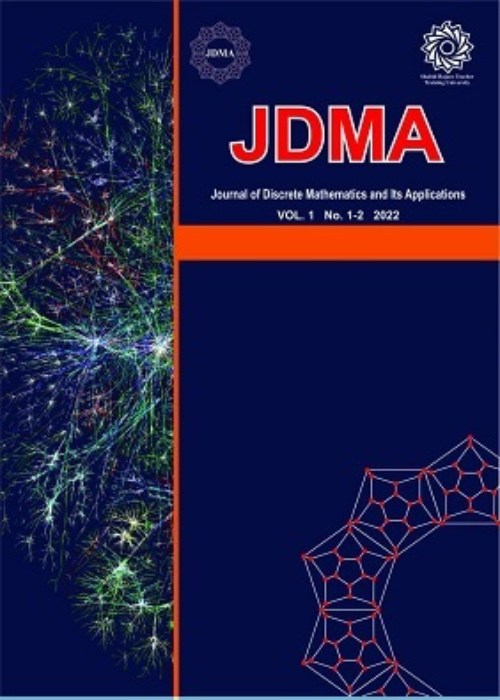فهرست مطالب

Journal of Discrete Mathematics and Its Applications
Volume:8 Issue: 4, Autumn 2023
- تاریخ انتشار: 1402/09/10
- تعداد عناوین: 6
-
Pages 205-212
The symmetric division degree $SDD$-index of a simple connected graph $G$ is defined as the sum of terms $f(d_u,d_v)=(d_u/d_v)+(d_v/d_u)$ over all pairs of distinct adjacent vertices of $G$; where $d_u$ denotes the degree of a vertex $u$ of graph $G$. In this paper, we introduce the general form of symmetric division degree index by replacing the degree of vertices $f(d_u,d_v)$ with another symmetric function of vertex properties. We establish some properties of the generalized symmetric division degree index $GSDD$ index for certain special functions and calculate the values of these new indices for some well-known graphs.
Keywords: Generalized symmetric division degree index, distance, total distance -
Pages 213-226Perfect state transfer (\textit{PST}) on graphs due to their significant applications in quantum information processing and quantum computations. In the present work, we establish a characterization of Cayley graphs over $U_{6n}$ group, having \textit{PST}.Keywords: Linear transformation, perfect state transfer, matrix representation, Cayley graph
-
Pages 227-237
Fullerenes are polyhedral molecules made of carbon atoms. These graphs have attracted much attention in the chemical and the mathematical literature. In the present paper, we investigate problems concerned with the eigenvalues of fullerene graphs. We obtain new upper bounds for the smallest eigenvalues of fullerenes using bipartite edge-frustration of their related subgraphs.
Keywords: fullerene, eigenvalue, cyclic-$k$-edge cutset, quotient graph, bipartite edge frustration -
Pages 239-247Let $G$ be a graph with a vertex weight $omega$ and the vertices $v_1,ldots,v_n$. The Laplacian matrix of $G$ with respect to $omega$ is defined as $L_omega(G)=diag(omega(v_1),cdots,omega(v_n))-A(G)$, where $A(G)$ is the adjacency matrix of $G$. Let $mu_1,cdots,mu_n$ be eigenvalues of $L_omega(G)$. Then the Laplacian energy of $G$ with respect to $omega$ defined as $LE_omega (G)=sum_{i=1}^nbig|mu_i - overline{omega}big|$, where $overline{omega}$ is the average of $omega$, i.e., $overline{omega}=dfrac{sum_{i=1}^{n}omega(v_i)}{n}$. In this paper we consider several natural vertex weights of $G$ and obtain some inequalities between the ordinary and Laplacian energies of $G$ with corresponding vertex weights. Finally, we apply our results to the molecular graph of toroidal fullerenes (or achiral polyhex nanotorus).\[5mm] noindenttextbf{Key words:} Energy of graph, Laplacian energy, Vertex weight, Topological index, toroidal fullerenes.Keywords: energy of graph, Laplacian energy, Vertex weight, Topological index, toroidal fullerenes
-
Pages 249-262
This article delves into the subject of topological modeling and invariants in the study of the Cosmic Web (CW), which refers to the vast network of galaxies in the universe. The article explores the use of eccentric connectivity and other topological descriptors to classify various structures within the Cosmic Web, such as filaments, walls, and clusters. By analyzing graphs and lattices in detail, the study shows how topological invariants can be used to extract morphological information and categorize nodes based on their structural roles. Additionally, the article discusses the potential application of these methods in assigning galaxy populations across different structures within the Cosmic Web. This research offers valuable insights into the use of topological tools for comprehending the intricate and complex nature of the universe's large-scale galaxy distribution.
Keywords: cosmic web, Wiener number, topological modeling -
Pages 263-271Recently, Shigehalli and Kanabur [20] have put forward for new degree based topological indices, namely Arithmetic-Geometric index (AG1 index), SK index, SK1 index and SK2 index of a molecular graph G. In this paper, we obtain the explicit formulae of these indices for Polyhex Nanotube without the aid of a computer.Keywords: Chemical graph, Degree-Based Topological Indices, Polyhex Nanotube

